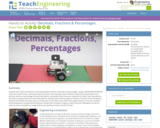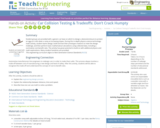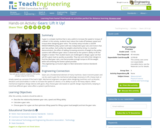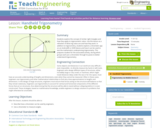
Preparing for a test requires lots of practice and this review will help students show what they know about how to use a number line.
- Subject:
- Mathematics
- Material Type:
- Lesson Plan
- Provider:
- BetterLesson
- Date Added:
- 12/01/2022

Preparing for a test requires lots of practice and this review will help students show what they know about how to use a number line.

Bianca visits a bike shop and learns how bicycle gears work in this Cyberchase video segment.

Chemical reactions are the foundation of chemistry, and understanding how elements combine and in what ratios helps us to understand the world around us. This pathway provides resources about how different chemicals react, and the ratios in which they react, a field of study known as Stoichiometry (literally: element measuring).

The x and y coordinates of the unit circle are discussed here, in the context of right triangles.

The x and y coordinates of the unit circle are discussed here, in the context of right triangles. This lesson [3:08] is 2 of 5 in the series titled "Coordinates on the Unit Circle."

This lesson introduces the concept of the cotangent of an angle. It is 4 of 5 in the series titled "Cotangent." [2:21]

Students learn about and practice converting between fractions, decimals and percentages. Using a LEGO® MINDSTORMS® NXT robot and a touch sensor, each group inputs a fraction of its choosing. Team members convert this same fraction into a decimal, and then a percentage via hand calculations, and double check their work using the NXT robot. Then they observe the robot moving forward and record that distance. Students learn that the distance moved is a fraction of the full distance, based on the fraction that they input, so if they input ½, the robot moves half of the original distance. From this, students work backwards to compute the full distance. Groups then compete in a game in which they are challenged to move the robot as close as possible to a target distance by inputting a fraction into the NXT bot.

How can an understanding of pH—a logarithmic scale used to identify the acidity or basicity of a water-based solution—be used to design and create a color-changing paint? This activity provides students the opportunity to extract dyes from natural products and test dyes for acids or bases as teams develop a prototype “paint” that is eventually applied to help with a wall redesign at a local children’s hospital. Students learn about how dyes are extracted from organic material and use the engineering design process to test dyes using a variety of indicators to achieve the right color for their prototype. Students iterate on their dyes and use ratios and proportions to calculate the amount of dye needed to successfully complete their painting project.

Students discover the mathematical constant phi, the golden ratio, through hands-on activities. They measure dimensions of "natural objects"—a star, a nautilus shell and human hand bones—and calculate ratios of the measured values, which are close to phi. Then students learn a basic definition of a mathematical sequence, specifically the Fibonacci sequence. By taking ratios of successive terms of the sequence, they find numbers close to phi. They solve a squares puzzle that creates an approximate Fibonacci spiral. Finally, the instructor demonstrates the rule of the Fibonacci sequence via a LEGO® MINDSTORMS® NXT robot equipped with a pen. The robot (already created as part of the companion activity, The Fibonacci Sequence & Robots) draws a Fibonacci spiral that is similar to the nautilus shape.

Student groups are provided with a generic car base on which to design a device/enclosure to protect an egg on or in the car as it rolls down a ramp at increasing slopes. During this in-depth physics/science/technology activity, student teams design, build and test their creations to meet the design challenge, and are expected to perform basic mathematical calculations using collected data, including a summative cost to benefit ratio.

This activity provides an opportunity for students to explore the ratio of the circumference of its circle to the length of its diameter in order to generalize the ratio of pi. [3:14]

Students learn about proportions using regular and souvenir baseball bats. This site contains a complete lesson plan, which is available in a printable version.

Students use their height and the length of the shadow to determine the height of buildings. A great outdoor activity to learn about proportions and ratios.

The CyberSquad tests which broom can travel the furthest in five seconds in this video from Cyberchase.

The CyberSquad tests which broom can travel the furthest in five seconds in this video from Cyberchase.

A gear is a simple machine that is very useful to increase the speed or torque of a wheel. In this activity, students learn about the trade-off between speed and torque when designing gear ratios. The activity setup includes a LEGO(TM) MINDSTORMS(TM) NXT pulley system with two independent gear sets and motors that spin two pulleys. Each pulley has weights attached by string. In a teacher demonstration, the effect of adding increasing amounts of weight to the pulley systems with different gear ratios is observed as the system's ability to lift the weights is tested. Then student teams are challenged to design a gear set that will lift a given load as quickly as possible. They test and refine their designs to find the ideal gear ratio, one that provides enough torque to lift the weight while still achieving the fastest speed possible.

This concept teaches students to find area and perimeter of similar polygons using ratios. Students examine guided notes, review guided practice, watch instructional videos and attempt practice problems.
A free CK-12 account is required to view all materials.

This study guide looks at similar polygons, scale factor (ratio), and triangle similarity.
A free CK-12 account is required to view all materials.

This study guide reviews ratios, proportions, and cross-multiplication.
A free CK-12 account is required to view all materials.

Students explore the concept of similar right triangles and how they apply to trigonometric ratios. Use this lesson as a refresher of what trig ratios are and how they work. In addition to trigonometry, students explore a clinometer app on an Android® or iOS® device and how it can be used to test the mathematics underpinning trigonometry. This prepares student for the associated activity, during which groups each put a clinometer through its paces to better understand trigonometry.